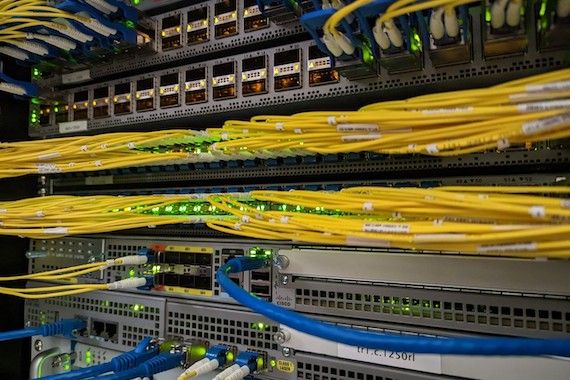Equipment at the heart of the QIX network (Montréa Internet Exchange. (Photo: QIX)
Techno Without Blind Spots analyzes current technologies, meets the minds behind these innovations, and examines the digital tools available to Quebec businesses. In this section, you can understand today’s trends to be prepared for tomorrow’s.
Techno without blind spots. If the Internet were a freeway network, the Montreal Internet Exchange (QIX) would be a shortcut from your computer to the servers of tech giants. After 10 years of focusing on Internet speed and latency in Quebec, QIX is now addressing another important aspect: its resiliency.
The names Cologix MTL1, Cologix MTL3, eStruxture MTL-1 and Vantage DC Montreal II don’t mean much to ordinary people. However, a large portion of Quebec’s internet traffic goes through these data centers.
“The Internet consists of several independent networks such as those of Google, Amazon and Internet Service Providers. An internet node is a kind of round table that enables all these networks to communicate directly with each other,” summarizes Karl Morin, CEO of QIX, which has connection points in each of the four data centers mentioned.
QIX is one of 600 Internet exchanges of its kind worldwide and the second largest in Canada after Toronto. About fifteen people are involved in its operation. QIX stands for Quebec Internet eXchange, its name was from 1995 to 2013 before it became a non-profit organization. Since then, the name has changed, but the acronym has remained.
An infrastructure for big players
Among the 99 members of the QIX are mainly internet service providers (e.g. EBOX, Cogeco and Telus), but also video game companies like Riot, web giants like Microsoft and large corporations like the Royal Bank of Canada.
“An internet exchange is mainly for organizations of a certain size,” admits Karl Morin. Those who need it usually have their own computer network and cannot afford to be dependent on a single Internet provider.
Participating in an Internet exchange also allows them to reduce their costs and ensures a fast connection with other companies with very low latency. “It is often for these reasons that members join the QIX,” observes Karl Morin.
Improve the resilience of the internet
However, it’s not the race for performance that is likely to define the QIX’s second decade, believes Karl Morin. “The big changes to watch will be on the internet resilience side,” he explains.
“The last few years have shown us how important the telecommunications infrastructure is in Canada,” adds the latter. Data centers are well protected (and run on diesel even in the event of a power outage), but hardware can fail.
Recently, a fire in an access shaft at Hydro-Québec in Montreal damaged fiber optic cables, causing several internet outages (though not for QIX members, but Karl Morin specifies, thanks to a redundancy in the exchange’s connections).
Karl Morin also regrets the current lack of transparency in Quebec’s Internet infrastructure. “Sometimes two ISPs can use the same fiber optic cable. A company that wants to make its infrastructure more resilient needs to know this,” he notes.
He also hopes that an internet exchange could see the light of day in Quebec in the coming years, which would increase the resilience of Quebec’s infrastructure. “Right now, Quebec traffic often has to go through Montreal. We should avoid that,” he said.
The QIX would be willing to settle there provided its members embark. “There’s no point in setting up an exchange if nobody connects to it,” notes Karl Morin. As a bonus, the organization would already have the correct acronym for the city.

Extreme problem solver. Professional web practitioner. Devoted pop culture enthusiast. Evil tv fan.




;Composite=(type=URL,url=https://images.radio-canada.ca/v1/assets/elements/16x9/outdated-content-2021.png),gravity=SouthEast,placement=Over,location=(0,0),scale=1)


